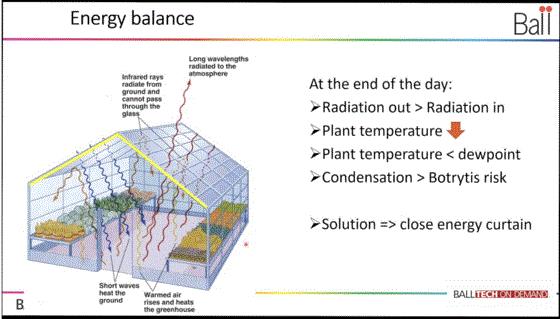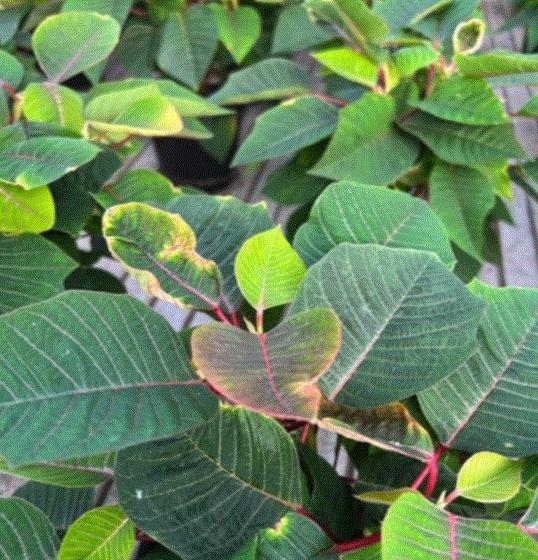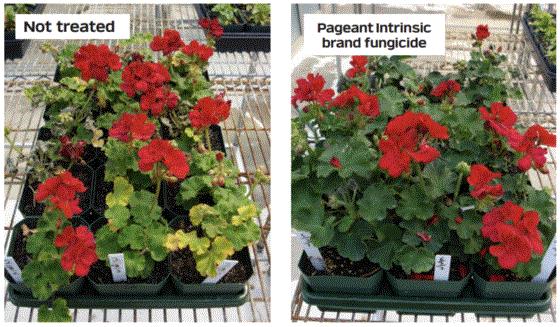Video: Energy Curtains Demystified
Have you ever wondered, “When is the right time to close my greenhouse energy curtain?” We often think that energy curtains are in place only to trap heat during the night and save energy. However, Tech On Demand expert Diego Poot explains how energy curtains can also play a critical role in reducing disease pressure.

Get the most from your energy curtains by using them to not only save energy but also to slow down your plants' temperature losses and minimize disease pressure. Check out this short VIDEO for the full scoop.
Nick’s Tip of the Week: (Ca)tch-Up Game
Each week, I’ll work with my buddy Nick Flax, a technical services expert at Ball, to share a concern that’s come up during one of his numerous calls with growers across North America. This week, he’s been hearing about calcium deficiency issues on poinsettia crops and has some tips to help you identify and manage the issue.
PROBLEM: While Week 43 is a little later than I generally start hearing reports of calcium (Ca) deficiency on poinsettias, this week has been full of them! Interestingly, for several of the growers I’ve talked with, Ca deficiency is not an issue they normally (or ever) have, and it seems to have snuck up on them. If this is a new challenge for you, here are a few indicators of Ca deficiency to look out for, reasons why Ca deficiency might be popping up in your poinsettia crop, and strategies to help overcome this unsightly mineral nutrient deficiency.

NICK’S TIP: Leaf and bract tip necrosis is generally one of the earliest indicators of an issue. Oftentimes, necrosis will progress outward along the margin from the tip as the leaf/bract continues to expand, and the leaf edge will become distorted (often described as a “drawstring” effect). As symptoms become more severe, leaves/bracts will begin to cup upward. Affected foliage does not recover or return to normal once symptoms progress, so be sure to look for early signs and react quickly to correct the cause.
What Causes Calcium Deficiency?
Some varieties are affected by Ca deficiency more severely and by different causes than others due to differences in physiology (genetics are funny that way), so early symptoms will likely pop up on one or two varieties first. On a basic level, however, two things cause Ca deficiency in plants:
-
Not enough Ca is being supplied to or taken up by the crop
-
There is insufficient movement of Ca in your plants
-
In cases where supply or uptake is the limiting factor, too-low overall fertilizer rates, use of a fertilizer with too little Ca during fall and winter months, or an imbalanced Ca to magnesium (Mg) ratio (FYI—the ideal range is 3:1 to 5:1 Ca to Mg), often due to poor or changing water quality that has gone unmanaged.
-
Calcium only moves via bulk flow of water through plants. When environmental factors like sudden drops in air temperature, high relative humidity and lower light levels limit uptake of water and transpiration, the flow of Ca slows or stops in the plant.
How Do You Combat Ca Deficiency?
Close management of your fertilizer program is the first line of defense against supply/uptake-related Ca deficiency. To prevent or correct this group of causal agents, be sure to:
-
Pick a fertilizer suited for the crop, your growing environment, and the time of year. Some growers use all-purpose fertilizers or ones formulated with higher amounts of ammoniacal nitrogen (such as 20-10-20) to push early growth on poinsettias. However, unless additional Ca is added to your feed later on or you alternate with 15-0-15 (calcium nitrate), many all-purpose feeds will not provide enough Ca to your crop. Use a Cal-Mag type feed (17-5-17 or 15-5-15), a “cool-weather” feed or fertilizer formulated for poinsettias (like Jack’s Poinsettia LX 20-5-19) to stay ahead of your crop’s Ca needs.
-
Properly mix your fertilizer to avoid accidental underfeeding and always double-check your fertilizer injector’s calibration each time you mix up a new batch of feed. Remember that poinsettias are generally high feeders, so periodical feeding at about 300 ppm N or constant feed at 150 to 200 ppm is a good target when plants are actively growing.
-
Get periodic irrigation water tests done if your water quality changes significantly throughout the year (especially if you use surface water). If your alkalinity is high, the chances that your Ca:Mg ratio may become unbalanced if you pick the wrong fertilizer increases. Having a recent water-quality report will help inform decisions on fertilizer section or if you need to acidify your water before injecting fertilizer.
If lack of Ca movement in your plants is the most likely cause of deficiency symptoms, do what you can to modify the growing environment to increase water uptake and movement.
-
When temperatures begin to drop, transpiration will decrease and relative humidity levels in the greenhouse will increase. Be sure not to run your greenhouse air temperature too cool, and dehumidify during the day when possible while your plants are actively growing.
-
Adjust your greenhouse ventilation setpoints to avoid “crashing” too much cool air down on your crop and causing transpiration to grind to a halt. When the seasons start to turn—like now, between October and November—be sure to restrict how wide your vents can open when outdoor air temperatures are in the 50’s F or below.
-
Increase air flow in your greenhouse, especially if venting/dehumidifying isn’t possible due to too-cold outdoor air temperatures. Add HAF fans if you have too few or make sure they are running more frequently. This can help drive transpiration and Ca movement even under adverse conditions.
-
If changing fertilizer and doing your best to manage the greenhouse environment still isn’t enough to prevent Ca deficiency, periodic foliar calcium chloride (CaCl) sprays may be your best option. Apply CaCl sprays at 200 to 400 ppm to “glisten” (not runoff) and be sure to mix in a wetting agent to ensure the solution spreads out across the leaf surface. Adding a wetting agent to the solution will enhance the rate of absorption and reduce the chances of phytotoxicity occurring. Weekly or bi-weekly sprays are appropriate, depending on the severity and frequency of the issue, but the goal should be to apply CaCl as few times as possible. Be sure to only use technical- or reagent-grade CaCl, as impurities in lower-grade CaCl can cause unrecoverable damage to your crops.

PODCAST: Growing for the Pro Landscape Market
Okay, I admit, this isn’t a cultural and technical topic, but it’s one that is critical for many of you serving the professional landscape segment or with plans to pursue that customer base.
In THIS EPISODE of Tech On Demand brought to you by GrowerTalks, I was joined by joined by Ball Hort's Lisa Lacy and Jeff Gibson. Lisa is a Portfolio Manager with PanAmerican Seed—a brilliant plant guru with a keen market sense, spotting trends far before they come to fruition. Jeff is Landscape and Independent Garden Center Business Manager with Ball and someone who knows our industry inside and out, with an ability to learn markets and help growers produce and deliver the crops relevant to each. Our topic this time was the Professional Landscape Segment—a huge part of our industry and one with particular wants, needs and nuances.

Both Lisa and Jeff are industry veterans, and with that experience comes plenty of stories, so sit back and enjoy a lively conversation about ways to work effectively, as a grower, with the professional landscape segment. We talk about how the market has changed over the years, what landscape professionals have shared about how they want product grown and delivered, the importance of trust and availability, and tips that have worked for many greenhouses. We also discuss how plant breeding and development has evolved to focus on landscape market needs, and the importance of trialing new varieties to determine durability and longevity in today’s landscapes. Finally, we wrap up with everyone’s favorite topic: new varieties and products proving success with professional landscapers and designers.

Don’t Stress About Shipping Stress
Our friends at BASF recently released a “Roots to Road” discussion featuring two of their technical specialists, Dr. Emma Lookabaugh and Jen Browning, who share thoughts on ways to manage shipping stress on ornamental plants that you send to wholesale customers. They explain that the stress caused to plants from sitting in warm trucks during the long journey is bad enough but can also lead to pest and disease pressures. And the last thing you want after putting in time, labor and money to grow high-quality crops is for them to be rejected.

As Emma so aptly puts it, “Never let down your guard. You don’t want to make it to the finish line only to lose the crop in the back of an 18-wheeler somewhere between the loading dock and market shelves.”
Read the FULL REPORT to learn about ways fungicides and insect growth regulators can be applied just before shipping to minimize losses and optimize plant quality. It might seem like you lose control once plant shipments leave your greenhouse but there are certainly steps you can take to reduce your risks, and Jen and Emma have plenty of ideas for your production and shipping teams.

Pre-season Fungus Gnat Control
Soon enough, your poinsettias will be out of the greenhouse and it will be time to get cleaned up for spring planting. If you and your team had to do battle with fungus gnats this year, there are strategies you can put in place to reduce the chances you’ll deal with them again in 2023. Your goal is to identify potential places in your operation where fungus gnats may be surviving from previous seasons and root them out.

Dirt, gravel, and other porous floor materials provide an excellent place for larvae and pupae to survive. Algae, decaying leaf litter and other plant residues that accumulate in porous/absorbent floors can serve as a food source for fungus gnat larvae. Where possible, renovate dirt or gravel floors and install a non-permeable surface. Also, installing weed fabric is better than leaving bare dirt or gravel floors. However, remember that weed fabric is permeable and needs to be cleaned and sanitized between crops so fungus gnats don’t take up residence.
Thoroughly clean (remove all debris and organic matter) and sanitize floors at the end of the season and between crops whenever possible. StripIt Pro and other commercial sanitizing agents help reduce algae growth and turn the floor into an inhospitable environment for pests like fungus gnats.
Since fungus gnat larvae and pupae can already be present in growing media or undiscovered reservoirs in your greenhouse, start applying preventative controls early.
-
Beneficial nematodes like Steinernema feltiae can be applied as early as sowing or sticking. These critters seek out fungus gnat larvae in growing media, go “alien” on them (parasitize them) and ensure their demise before they can develop or reproduce.
-
Insect growth regulators (IGRs) containing azadirachtin (ex. Azatin, Molt-X) can be applied as substrate drenches early in crop cycles to disrupt fungus gnat larval development.
Note: Both of these measures are only effective against fungus gnat larvae (not adults) and must be deployed preventatively for best effect.

Finish Line …

Nick’s tech tip above, covering calcium deficiency in late-season poinsettias, reminded me that although our favorite holiday plants are nearing the finish stages, there’s still plenty that can go wrong. And the later in the production cycle it gets, the more costly the losses. So I’ll close this newsletter with a quick reminder that Tech On Demand has you covered with a full series of poinsettia production videos, more than 30 in total, covering just about everything you need to know to optimize production and tackle any issues that arise.
You can find the complete playlist HERE.
Please feel free to send your comments, constructive criticism and topic ideas to me at bcalkins@ballhort.com.

Bill Calkins
Editor - Tech On Demand
This email was received by you and 26,288 other fine subscribers!
If you're interested in advertising in Tech On Demand, contact Kim Brown ASAP and she'll hook you up.